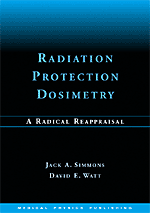
Radiation Protection Dosimetry: A Radical Reappraisal
Author: Jack Simmons & David WattISBN: 9780944838877 ISBN10: 0944838871
Published: 1999 | 160 pp |
OUT OF PRINT
Health Physics | September 1999
“This slim well-written volume deserves its place on the bookshelf of most radiobiologists, containing, as it does, a usefully-brief ‘pen picture’ of most of the standard models that have been considered in radiation biology. This makes Chapter 4 a very useful teaching tool.
“What is presented in the original parts of the book (Chapters 5 and 6) is a model of radiation-induced DNA double-strand break (DSB) induction, with a formalism which is similar (though not identical) to that presented by Bob Katz (e.g., Butts and Katz 1967). Over the years, this type of approach has been extensively critiqued (e.g., Zaider 1990: Goodhead 1991), and equally vigorously defended (e.g., Katz 1991). The approach features the use of risk cross sections multiplied by charged-particle fluences to produce yields of, in this case, DSB; in fact the authors stress the use of a ‘fluence-based’ system rather than a ‘dose-based’ system at some length, this being their ‘radical reappraisal.’ They are not the first to point out the advantages of fluence-based risk modeling - both Katz (1994) and Curtis et al. (1995) have stressed this. At high LET, using fluence is rather more intuitive than using dose, but fluence is essentially dose divided by LET, so the argument is really more about terminology than anything else.
“A more fundamental issue is the authors’ suggestion that the radiation-induced DSB is the fundamental lesion controlling both radiation protection and radiotherapeutic response. For radiotherapy this is clearly not the full story: at radiotherapeutic doses, cells are killed primarily through dicentric chromosome aberrations, and it is quite clear that yields of DSB cannot be ‘scaled’ (as the authors suggest) to predict yields of these chromosome aberrations. For example the relation between DSB and dicentrics at low LET is quite different from the relation between DSB and dicentrics at high LET; whether this is due to the production of more damaging DSB at high LET (Goodhead et al. 1993; Sachs and Brenner 1992), or due to the increased proximity of DSB at high LET (Sachs et al. 1997; Brenner 1990), is still being debated but, either way, using only the yield of DSB as determinant of cell killing at radiotherapeutic doses is unlikely to be successful. At lower doses, on the other hand, yields of dicentric chromosome aberrations are not sufficient to explain rates of cell killing (Sachs et al. 1997a,b); here other processes, such as point mutation and apoptotic processes, both potentially better correlated with DSB, imply that yields of DSB may indeed by a reasonable indicator of risks of low-dose cell killing.
“Of course, for radiation protection at low doses, cell killing is not very important, and carcinogenesis is the issue. Though the evidence is sparse, it seems unlikely that the DSB is the key lesion that correlates with the risk of radiation carcinogenesis. For example, the link between leukogenesis and chromosomal translocations is well documented (Rowley 1998), and the same arguments, discusses above, about the lack of scaling between DSB and dicentric chromosome aberrations, also apply to the link between DSB and chromosomal translocations. So the authors are being quite speculative in attempting to use a model of DSB formation as a general model for low-dose radiation protection.
“Whatever the pro’s and con’s of the authors’ model, it does imply a linear relationship between low fluences and risk (and therefore between low doses and risk). Nevertheless, the last four pages of the book are devoted to a critique of the ‘linear no-threshold’ model currently used in radiation protection. Here the authors’ arguments are not very convincing. The authors suggest that lung cancer data from uranium miners ‘indicates that the increase in exposure has little effect on the incidence of lung cancer up to levels as high as 300 to 400 WLM; i.e., about 3 to 4 Gy. Not unreasonably... these findings can be interpreted as practical thresholds for the induction of lung cancer by radon progeny.’ This really flies in the face of the epidemiological data; as Fig. 1 indicates, there is certainly a significantly increased lung cancer risk at an exposure of 400 WLM, and almost certainly a significantly increased risk even at an order of magnitude lower exposure.
“There is, of course, an ongoing debate about the risks of still lower (i.e., typical domestic) radon exposures. If we exclude the ecological data from Bernard Cohen (e.g., 1997), because of their apparently insuperable (Lubin 1998) methodological problems, we simply have no epidemiological data to work with, and we are likely to be reliant, for some time to come, on models and laboratory experiments for our low-exposure risk extrapolations. The authors’ fluence-based model certainly does not imply a threshold - to the contrary: if we agree, for example, that a minor exposed to 150 WLM does have an increased risk of lung cancer (Fig. 1), it is easy to calculate that the average number of alpha particles traversing his bronchial basal cell nuclei per year is about 0.25 (NAS 1998) - prima facie evidence that a single alpha particle traversal can be the cause of lung cancer: and if a single alpha particle traversal can cause lung cancer then, in the authors’ fluence-based model, any radon exposure, no matter how low, would have the potential to cause lung cancer, with a probability simply proportional to the radon exposure.
“Overall, this book is well worth reading, but don’t expect the promised ‘radical reappraisal.’ And it’s unlikely that many uncommitted readers will be convinced, as promised on the back cover, that ‘the [authors’] model excludes the linear, no threshold (LNT) model of radiation risk and suggests a threshold of 0.2 Sv for low linear energy transfer (LET) radiation and a much higher threshold for high LET radiation.’”
David J. Brenner
Columbia University


